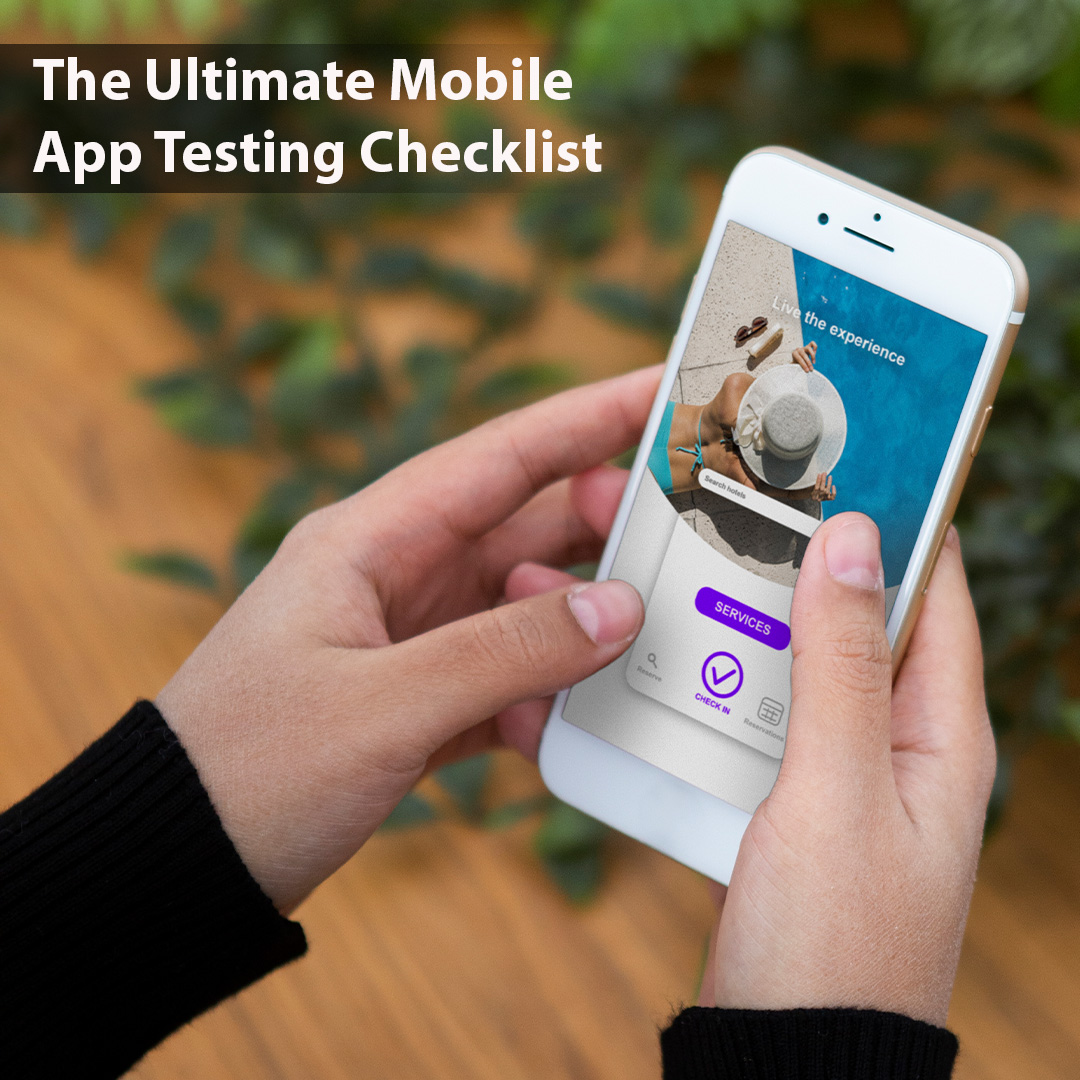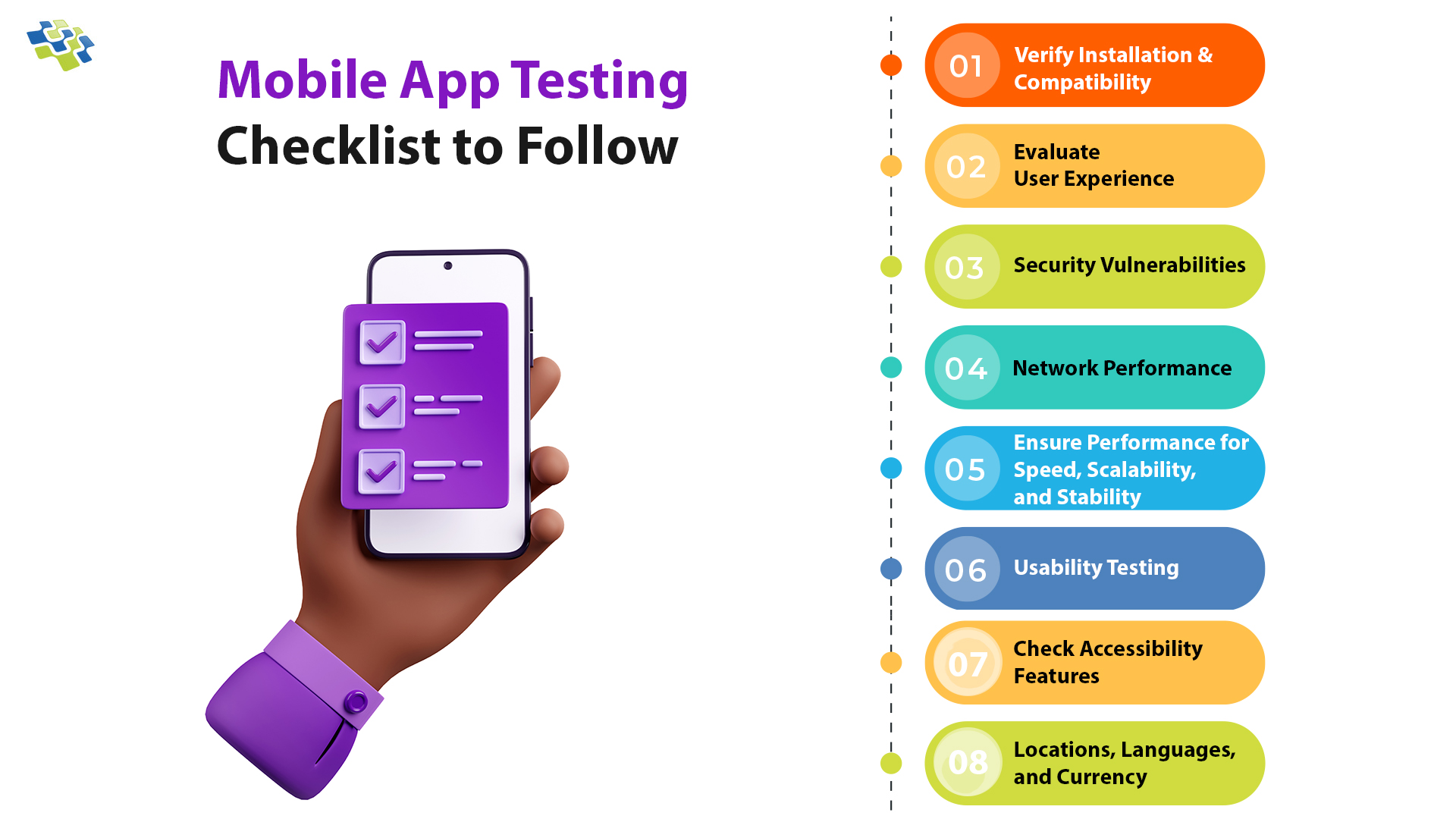The Ultimate Mobile App Testing Checklist
This comprehensive mobile app testing checklist is designed to offer valuable insights. It caters to the needs of testers, product managers, DevOps professionals, and QA engineers who are dedicated to ensuring an exceptional user experience through mobile applications.

“By 2027, the software testing market is expected to reach a revenue valuation of approximately USD 60 billion.”– Global Market Insights
Given the foundational nature of these ideas, it is prudent to consider practical strategies before delving into the checklist. By embracing sound tactics, you can effectively optimize the testing process and enhance its overall efficacy. There are several different types of testing that must be done for any mobile app to be successful such as Functional Testing, Device Compatibility Testing, Performance Testing, Security Testing.
What Justifies the Need for Mobile App Testing?
The primary goal of developing mobile apps is to extend the global reach of businesses and connect with a broader user base. However, if the software is flawed or cumbersome to navigate, it diminishes the likelihood of user adoption. Undoubtedly, no company desires to witness their customers uninstalling their apps in favour of competitors. It is imperative, therefore, to prioritize seamless functionality and intuitive user experiences, ensuring that users are motivated to engage with the app and remain loyal to the brand.
Insufficient testing of mobile apps can lead to significant issues on users’ devices, diminishing the overall user experience, particularly for those who are less familiar with the technology. The initial impression of a mobile app plays a pivotal role in determining its success. Unexpected app crashes or functional flaws can quickly lead to its removal from users’ devices, resulting in missed opportunities for attracting new clients and generating revenue. Following are some pertinent statistics that demonstrate the need for mobile app testing:
- Most app users, specifically around 80%, opt to delete or uninstall an application when it fails to meet their expectations.
- Slow-loading apps can lead to a significant loss of user engagement, with statistics indicating that half of users, approximately 48%, choose to deactivate or discontinue using an app that suffers from sluggish performance.
Mobile App Testing Checklist to Follow
To ensure a positive user experience, mobile apps must prioritize smooth navigation and consistently deliver value. This checklist helps developers identify and address issues pre-launch, safeguarding app quality and meeting user expectations.
 1. Verify Installation & Compatibility
1. Verify Installation & Compatibility
During mobile app testing, it is crucial to focus on installation and compatibility. This entails verifying that the app can be installed accurately on a variety of devices, operating systems (such as iOS and Android), and their respective versions. Additionally, it is essential to ensure compatibility with different screen sizes, resolutions, and orientations, ensuring that the app displays and functions appropriately across various devices. Another important aspect is testing for compatibility with different network conditions, including 3G, 4G, and Wi-Fi, as well as checking the app’s offline functionality. By thoroughly addressing these installation and compatibility factors, the mobile app can provide a seamless and consistent user experience across diverse platforms and environments. Utilizing a cloud-based service that grants access to genuine devices for testing purposes is strongly advised. These platforms offer an extensive array of actual hardware and browsers for both manual and automated testing. With tens of thousands of real Android and iOS devices at your disposal, it simplifies and enhances comprehensive automated app testing.
2. Evaluate User Experience
Front-end testing serves as a crucial validation process to ensure the seamless functionality of a mobile app’s graphical user interface (GUI). It focuses on meticulously verifying the various functionalities offered within the UI, including but not limited to menus, dropdowns, navigational buttons, gestures, forms, and other interactive elements. By conducting comprehensive front-end tests, the app’s compatibility and responsiveness can be ensured, allowing it to cater effectively to a diverse user base. By employing a comprehensive array of testing techniques, front-end testing facilitates the delivery of a high-quality mobile app that surpasses the expectations of end-users and operates flawlessly across a wide range of platforms and devices.
3. Security Vulnerabilities
In the realm of mobile app development, prioritizing security is paramount. With the exponential growth in the volume of data stored on app servers and the increasing power of mobile devices, the risk of data breaches has become a significant concern. Hackers employ intricate methods to exploit vulnerabilities and pilfer crucial data in transit. Unsecured protocols or compromised mobile devices pose potential access points for unauthorized intrusion. Therefore, it is essential to have comprehensive mobile app security testing in place, regardless of whether you are developing a new app, testing an existing one, or designing your mobile strategy. Security testing also checks for common security flaws like cross-site scripting (XSS) and SQL injection. By conducting thorough security testing, app developers can identify and mitigate security risks, safeguard user data, and provide a secure user experience, instilling trust and confidence in their applications. This also includes encryption of locally stored data on the device, secure storage of confidential information, thorough testing of biometric unlocking options such as fingerprint or Face ID, and evaluation of the effectiveness of Two-factor Authentication (2FA) mechanisms.
4. Network Performance
To comprehensively evaluate the performance of your application in different network scenarios, it is essential to conduct tests under various network settings, including situations with poor signal strength and during data transfer. During these tests, several key factors should be considered to accurately assess the network performance:
- Jitters- Data collection delays can lead to packet scattering during transmission, causing the data to become scrambled, a phenomenon commonly referred to as jitters. In such instances, it is crucial for the application to proactively prompt the user, offering the option to either resend the data or patiently await the system’s response.
- Packet Loss- In the event of complete packet loss, it is imperative for the application to take appropriate action such as resending the data request or promptly notifying the end user. Instead of subjecting the user to an extended waiting period, the app should proactively prompt them to retry the operation.
- Network Speed and Type- To ensure a seamless user experience, it is essential to account for the variability of network speeds. Thoroughly testing the application across different networks and varying speeds can provide valuable insights into its behaviour. Specifically, it is crucial to evaluate how the app responds when transitioning between mobile data and Wi-Fi networks, as well as vice versa. By conducting these tests, potential issues can be identified and addressed, ensuring optimal performance and user satisfaction.
5. Ensure Performance for Speed, Scalability, and Stability
A comprehensive mobile application testing strategy necessitates the inclusion of performance testing as a vital component. This type of testing evaluates the scalability, responsiveness, and speed of the application across a wide range of scenarios. By conducting this testing, the application’s performance can be thoroughly examined and analyzed in various contexts and usage patterns. It enables an in-depth assessment of how well the application can handle increasing loads, respond promptly to user interactions, and maintain optimal speed under different conditions. It encompasses the evaluation of app speed and performance in different geographic locations and under network conditions that impose data throttling, such as 3G, 4G, and LTE. By simulating increased concurrent sessions and transactions, mobile app performance testing enables a thorough assessment of the application’s performance. This ensures that the app remains robust and performs optimally, even when subjected to prominent levels of stress from backend servers, databases, and other relevant factors.
6. Usability Testing
Usability testing is crucial for a positive user experience. It involves evaluating various aspects of digital products, such as navigation, design, color usage, data confidentiality, user diversity, breadcrumbs, buttons, and menu structure. Sitemap evaluation helps improve navigation, while user-friendly and trustworthy design enhances engagement. Careful color usage ensures a visually pleasing experience, and privacy measures are crucial for sensitive information. Diverse user testing captures different perspectives for inclusivity. Breadcrumbs aid navigation, and button issues like alignment, content, and color should be addressed. Well-organized menus avoid clutter, and effective use of white space improves readability and balance.
7. Check Accessibility Features
Ensuring adherence to accessibility standards is not only a regulatory requirement but also a best practice for mobile applications. By catering to a broader user base, including individuals with specific disabilities, conducting accessibility testing further enhances the app’s overall effectiveness. When planning for accessibility testing, it is essential to consider the following factors, as they play a significant role in determining the app’s inclusivity and usability.
- Font size
- Speech recognition
- Color ratio and contrast
- Zoom In/Out
8. Locations, Languages, and Currency
To create a personalized and tailored user experience, mobile apps should effectively address the concepts of location, language, and currency. Localization testing and internationalization testing should be prioritized, considering the target audience. A prime illustration of this is Amazon’s mobile app, which adeptly identifies the device’s location and presents products available for delivery in that region. Furthermore, the app employs GPS technology to store the user’s current address and preferences, thereby facilitating future purchases. Giving utmost importance to these testing aspects ensures that the mobile app caters effectively to users worldwide, delivering a personalized and seamless experience. To ensure seamless functionality across various geographic regions, geolocation testing becomes imperative. Additionally, to achieve broad international appeal, mobile applications should support bilingual capabilities. By prioritizing these aspects, apps can provide a truly engaging and inclusive experience to users worldwide.
Conclusion
As the world increasingly embraces mobile technology, ensuring the quality of your mobile applications becomes paramount. Testing plays a vital role in the development process, and its significance is even more pronounced for mobile apps. Several compelling reasons underscore the importance of testing mobile apps. Firstly, mobile devices are inherently less forgiving than desktop computers, meaning any coding flaw is likely to manifest on a mobile device. Secondly, the diverse hardware and software configurations of mobile devices necessitate app compatibility across various platforms without encountering critical issues. Lastly, users have lofty expectations for mobile apps, demanding responsiveness, and seamless performance. A sluggish or buggy app can swiftly lead to user dissatisfaction and abandonment in favor of alternatives. Therefore, placing substantial emphasis on rigorous testing is essential for mobile app development, as it can determine the difference between a successful launch and a disappointing outcome.
Ready to ensure a flawless mobile app launch? At NextGen Invent, we specialize in app development and testing, providing you with a comprehensive solution for your mobile app needs. Our team of experts follows the ultimate mobile app testing checklist, leaving no stone unturned to ensure a seamless user experience. From functionality and performance to compatibility and security, we meticulously examine every aspect to ensure your app’s success.
Don’t let subpar testing compromise your app’s potential. Contact us today and let us help you launch your mobile app with confidence. Your success is just a click away.
Further read: How to Build a Robust API Architecture?
Stay In the Know
Get Latest updates and industry insights every month.
